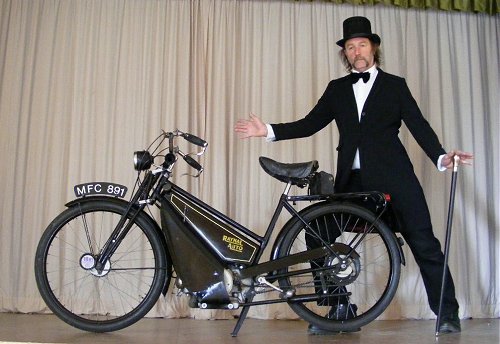

(Autocycle Roadshow) Second Act
The stage curtains undulate toward the middle, and the
compère’s head appears through the parting. He
pats down his top hat and stares wildly around the sparse
audience...
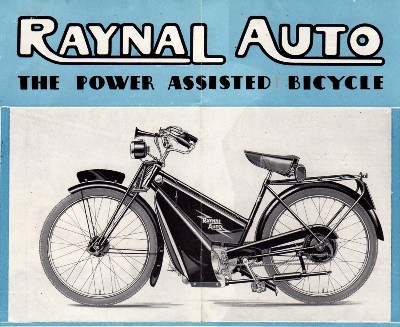
Raynal De Luxe brochure picture
Some new faces I do not recognise … some
I feel we may have seen in this place before [he winks at us]
… would presumably wish to know how our tale of old Raynal
continues? Allow me to recap for the benefit of those
unfortunate to have missed our first performance…
He twiddles his moustache while glaring at a couple of late
arrivals stumbling to their seats.
In launching its autocycle in 1937, Raynal
became the first manufacturer with the new Junior engine, but
there was to be no monopoly, as Villiers licensed its motor to
many more companies over the following years.
With the decline in business of building
‘own-make badged’ cycles for trade customers, Raynal
purchased the rights to Dunelt Cycles in 1937, buying into an
established brand name, and ready access to its network of
retailers. 1938 advertising finds the
Dunelt Cycle Co now listed at Raynal’s address at
Woodburn Road, Handsworth, Birmingham 21.
Production at Raynal ended during 1940, for the
rest of the duration, over which period there appears no
confirmation about how the plant was deployed. In common
with other cycle manufacturers, munitions work seems likely.
The wobbly vertical leaf sprung pivot fork
failed to re-appear with the emergent machine after the
war. Gone too was the rod-linked, back-pedal brake
arrangement, in favour of an inverted lever operated cable
set. Production and sales resumed in 1946 with the
‘Popular’, a naked-frame JDL powered autocycle fitted with a straight tube,
centrally sprung girder fork set of own manufacture. For
1947, the machine was re-posted as the
‘De Luxe’, now equipped with a combined
engine/legshield set, and the covers hinged at the tank to allow
easy service access.
A listed price at £52 19s 6d
now starkly illustrates how the inflationary rate had practically
tripled the cost of a Raynal over the decade since the autocycle
was originally launched for just £18 18s 0d in
September 1937.
The curtains sweep aside to reveal a new Raynal standing in
the centre of the stage, and the compère strides over to
strike a theatrical pose while indicating features with his cane
as related in the monologue.
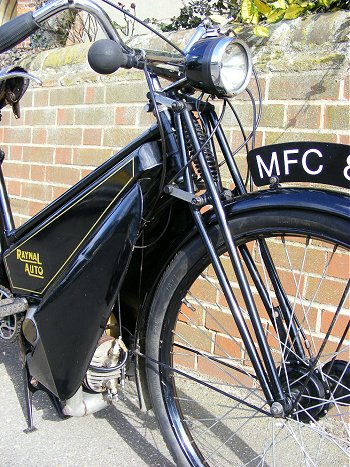
This post-war Raynal De Luxe model
registered on 26th June 1947 wears frame number 6820 and comes complete with all original fittings
and full panel set. The coloured tank patterns of pre-war
models were succeeded by the melancholy all-black paint finish of
post-war austerity, only broken by minimal gold coachlines to the
petrol tank, and small items of chrome brightwork on the
handlebar set, pedal cranks, and fork links.
Still tucked at bottom right of the tank, we
note the petrol tap now sports a reserve lever, so there’s
progress for you!
The engine shield set very effectively deters
any thoughts of groping in their dirty cavernous gloom in search
of the carb flood button, so we just pull the choke knob on the
left side of the tank, decompress, spin the motor a couple of
times, and it readily fires up with a tweak on the
throttle. The bike sits ticking over steadily as we get
kitted up, roll off the centre stand (much less fuss than rear
stand arrangements), then a light boost on the pedals to aid the
single gear take-off, and the JDL responds with a steady urge as we
load on the throttle.
Vibrations wave through the handlebars and
pedals at certain speeds, and panel resonation becomes noticeable
under hillclimbing load, but neither particularly intrudes upon
the ride. Handling was confident enough to be able to take your
hands of the bars without any fear of the bike diving into the
hedges, and the girder fork set rode well enough that the pilot
was never conscious of any bumpy feedback. While brake
function was good, their operation was cumbersome and difficult,
made awkward by the inverted lever arrangement.
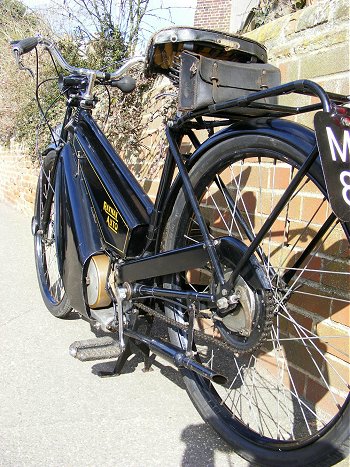
With the rider sitting upright, the pace bike
recorded best on flat as 29mph, and still maintaining a fairly
upright posture since the handlebar form and riding position
discourage adopting any effective crouch, our wing man clocks off
a 36mph maximum for the
downhill run.
In 1947, Raynal was bought by British
Plasterboard but seems to have carried on as before. Raynal
was further bought out by Tube Investments in 1950, and melted
into anonymity within the sprawling British Cycle
Corporation. Long time Managing Director
A B Jackson left Raynal at this time, to set up his own
company ABJ, and produced a new
autocycle frame to take the Villiers 2F motor.
Raynal never did go on to develop a chassis for
the 2F engine, choosing instead to soldier on with the last
remaining stocks of the JDL for their
outdated frame, while all the other manufacturers moved on.
They were the first manufacturer selling the new Villiers Junior,
and the last manufacturer selling the old Villiers Junior
De Luxe engine.

Raynal advert used
throughout
1947, 1948 & 1949
It’s hard to draw a line exactly when
Raynal ceased making autocycles, their obsolete machine just
seemed to gradually fade away. They were clearly listing
their autocycle up to the end of the sales season in late 1950,
though other references suggest that old stock was still being
sold up to 1953.
At conclusion of manufacturing, frame
numeration indicates around 8,000 autocycles having been
built.
Raynal never sold any of its autocycles under
the Dunelt badge, which may have been secured just too late to
apply the brand and, having launched under their company name,
they seemingly decided to stay with the label.
TI
acquired Raynal purely to secure the Dunelt Cycles brand, and in
1951 we find the business now listing its office address as
Dunelt Cycle Co Ltd, Cornwall Road, Smethwick,
Birmingham 40 (though only the
next road down from the old Raynal cycle works). It appears
that, while TI had acquired
the rights to Raynal and Dunelt, the actual factory premises had
been retained by British Plasterboard.

Dunelt cycles trade advert
TI
Reynolds Tube Manipulators produced a series of prototype model
mopeds in the mid 1950s, one version of which, fitted with a Rex
engine, became listed under the Dunelt brand—though never
actually went into production.
February 1959 finds Dunelt Cycle Co Ltd
registered from Rabone Lane, Smethwick, Birmingham 40,
though apparently no more than an office from another side of the
old Raynal factory block, which now seems to have been renamed
‘Attercliffe Works’ in some reflection back to
Dunford & Elliot’s history from that area of
Sheffield.
Dunelt branded cycles continued to be sold up
to the last years of the 1960s, though headstock badges reveal
these later machines of Nottingham origin as the brand
transferred to Raleigh. Some Raynal branded cycles were
also sold at this time; these also came from Nottingham and were
for export only.
The performance is over, and with the audience, we drift back
into the musty gloom of the lobby. One last look around for
sentiment’s sake, knowing we may never return to this
theatre, nor see the strange Autocycle Roadshow ever again, but
we must press on with our quest.
Rain still falls from the darkened skies—Birmingham
certainly gets its share! We hail a taxi to avoid another
soaking and, through the back window, watch people leaving the
foyer as the lights of the theatre fade into the night.
Another chapter is ended, but we are suddenly aware how
unnaturally cold it has become within the cab! The dials of
the meter seem to be running backwards, then suddenly, we appear
to have arrived—the driver turns, ‘That’ll be
1946 thanks guv’.
Next—Sometimes there are different ways of doing
things, and Antonio Meucci has the vision to see an Alternative to the
Autocycle. Originally written in 2008 for IceniCAM, a franchised version of this article was
suddenly called for publication in another magazine before a slot
appeared in our own programme—now we’re just catching
up with ourselves!
[Text and photos © 2009
M Daniels. Period documents from Keith Flood and the
IceniCAM Information
Service.]
Library
Raynal documents in the On-line Library:
Cycle and motorcycle catalogue 1922
Raynal-Auto advert 1937-09-17
Raynal-Auto advert 1937-12-31
Raynal-Auto advert 1938-05-20
Raynal-Auto advert 1949-10
Raynal-Auto article 1937-09-15
Raynal-Auto article 1937-09-16
Raynal-Auto article 1937-09-17
Raynal-Auto cutting 1937-09-22
Raynal-Auto instruction book 1939
Raynal-Auto leaflet 1937
Raynal-Auto leaflet 1938
Raynal-Auto leaflet 1939
Raynal-Auto leaflet 1949
Raynal-Auto road test 1938-05-26
Dunelt documents in the On-line Library:
CCL advert 1956-04-28
Company cutting 1937-09-17
CRL advert 1955-08-20
CRL advert 1956-02-04
CR advert 1956-06-23
Cycles adverts 1937
Cycles advert 1938-02-18
Cycles advert 1938-03-18
Cycles advert 1938-06-10
Cycles cutting 1937-09-17
DC advert 1956-03-31
E advert 1955-11-12
E advert 1956-05-26
K advert 1956-03-03
LT Diadem advert 1953-11-18
LT Diadem advert 1954-11-17
Z + ZL Dart advert 1953-11-11
Z + ZL Dart advert 1954-11-10
Z Dart advert 1951-11
Making Second Act
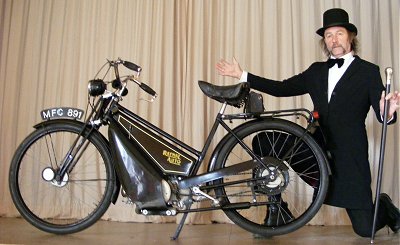
Ashley Stanbridge as The
Compère
A derivative of IceniCAM’s Autocycle Roadshow of April 2009 edition was
simultaneously published in the April/May edition of the Ipswich
Transport Museum’s Priory Press
magazine, as Raynal Autocycle Exhibit,
though this two part franchise version was a very different
presentation. With the ITM on a
bi-monthly schedule, their second part appeared in the June/July
2009 edition of Priory Press, while
IceniCAM’s more stylised production of Second Act had to wait for its September slot to come
up. While all the pictures, road test elements and first
draft had pretty much been in the can since March 2009, the file
hadn’t actually been worked into any finished text, so
there was still quite a bit of writing required to work it into
the Autocycle Roadshow sequel.
The featured post-war model came thanks to Keith Flood, who
also gave IceniCAM full access to his
comprehensive files, collected over many years as Raynal
specialist (now retired). With publication of our sequel
article concluding the Raynal feature, we’ve hopefully done
justice to all Keith’s years of research, and completed
reasonably definitive reference pieces to the disappeared
marque.
Contrasting the night shoot of the first part The Autocycle Roadshow, the cover pictures of
Second Act were taken the following day
on the stage at the local village hall, with Ashley Stanbridge
again appearing as the character of the compère.
Pictures were all digital, but again fuel for running about
was what accounted for the main production cost of
£25. Regular autocycle feature supporter Jeff Lacombe
scores another sponsorship credit for the Leicester
Enthusiasts.
Feedback
March 2022
My grandad, Richard Darlow, closed down production. My
dad (his son-in-law) worked at the factory from 1960 to 1963 and
said there were still lots of parts laying about. His first
job (in junior management) was to clear the whole lot out.
In fact my mom and uncle both had one built out of spares.
At the time it was in Woodburn Street in Handsworth.
My grandad was the Managing Director of H Gill (Stampings)
Ltd.
Regards
Andy Williams.



